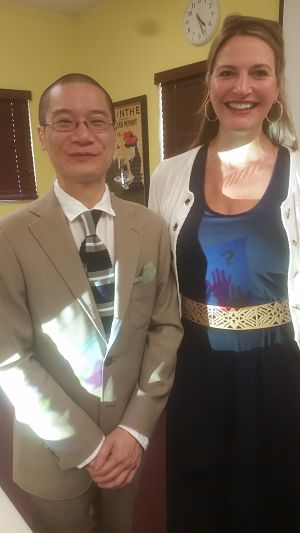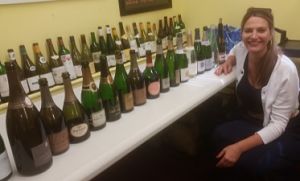
Peter Liem and Sherry Truhlar
Welcome to wine week! Every post this week ties to alcohol. Here’s the post explaining it.
Where does a fundraising wine auctioneer go to learn about champagne?
Drinking it often is a good start.
But to more fully appreciate the bubbly, this past Monday (June 1, 2015) I headed to class.
This just wasn’t any class. I went to the Champagne Master Workshop & Tutored Tasting organized by the French Wine Society.
Peter Liem, one of the world’s experts on champagne, led the course. My brother is a huge fan of his and I can see why so many are eagerly awaiting Peter’s book.
I’ve copy and pasted the course syllabus from the website below. For those of you with an interest, you’ll appreciate the ~20 examples of some pretty impressive bottles we worked through.
The room was packed with 36 students from near and far. The man to my left worked for Krug and flew in from Miami; the woman to my right was a passionate wine student.
========

Peter Liem instructs champagne class in Washington, D.C.
Champagne Master Workshop & Tutored Tasting – Washington DC
Date: Monday, June 1st 2015
Time: 5 hours total: 10am-1pm; 2pm-4pm (lunch not included)
Location: The Capital Wine School, 5207 Wisconsin Avenue, Suite # 7, Washington, DC, 20015
Instructor: Peter Liem
Tuition: $250

Comparing color.
This 5-hour workshop, led by Champagne expert Peter Liem is designed for students enrolled in the French Wine Society’s Champagne Master-Level Program, but is perfect for anyone who wants to explore Champagne at the deepest level.
Time to put theory to the taste test with an exemplary line-up of special wines! By working through nineteen still and sparkling examples, students will review the climate, soils, sub-regions and winemaking process of Champagne in an interactive format. Come prepared to sip, savor and discuss the factors that make champagne the most unique and distinctive sparkling wine on planet earth.
The Champagne Master Workshop & Tutored Tasting will be structured around a series of champagne flights.

Some of my notes…
Flight One: Still Champagne (Red, White and Rosé)
Learn the AOCs…and review the climate that engenders this style of high acid wine.
- Pierre Paillard, Coteaux-champenois – Red
- Henri Giraud, Coteaux-champenois – White
Flight Two: The Grapes and their Terroirs
Taste Pinot Noir from Reims marl/chalk and Kimmeridgean marl; Pinot Meunier on clay and sandstone; Chardonnay on chalk and Pinot Blanc on Kimmeridgean marl. You’ll taste wines from old vine fruit and pre-phylloxera vines while discussing the sub-regions, terroirs and meso-climates of this diverse wine region.
- Tarlant, La Vigne d’Or Brut Nature (100% Meunier)
- Drappier Blanc de Noirs Brut Nature (100% Pinot Noir)
- Jerome Dehours, Blanc de Meunier (100% Meunier)
- Pierre Peters, Cuvée de Reserve Blanc de Blancs (100% Chardonnay)
- Pierre Gerbais, L’originale Blanc de Blancs (100% Pinot Blanc)
- Pierre Paillard, Bouzy Grand Cru Blanc de Noirs “Les Maillerettes” 2009 (100% Pinot Noir)

A look at most of the bottles we worked through in class.
Flight Three: Winemaking
Review the champagne process while comparing and contrasting champagnes that do/do not undergo malo-lactic, that are/are not aged in wood…plus rosé made by adding Pinot Noir still wine vs. rosé de saignée.
- J-L Vergnon, Eloquence Extra Brut
- Jacquesson, Cuvée No. 737
- Billecart-Salmon, Sous Bois
- Ayala, Brut Nature
- Laurent-Perrier, Rosé
- Egly-Ouriet Grand Cru Brut Rosé
- Champagne Fleury Fleur de l’Europe NV
Flight Four: Vintages
Hone your tasting technique and vocabulary by examining the structures and aromatic profiles of vintage champagne made during a classic year, a warm year and a cool year. What defines an age-worthy wine? How do vintage champagnes differ from NV bottlings?
- Louis Roederer, Vintage 2007
- Pol Roger, Vintage 2004
- Ruinart, Dom Ruinart
- Philippe Gonet Blanc de Blancs 2007
- Taittinger, Brut Millésimé, 2006
- Alfred Gratien Classic Millésime 2000
Flight Five: Q& A and Champagne at Table
Explore the sensory impact of a demi-sec champagne and pound cake vs the same dessert and the same wine decanted! Sample champagne’s huge side industry: marc de champagne truffles. Review key points of study with an interactively sweet finish to the day.
- Veuve-Clicquot, Demi-Sec”
========
One of my strengths as a benefit auctioneer has always been that I know what I’m selling. If the bidding stalls … even if the item is as simplistic as dinner with the Headmaster … I want to have a back-up anecdote or two to re-ignite bidding. It might be a quick comment about how the Headmaster is an entertaining story-teller, or that his wife makes a killer martini.
The point is, I want to know my merchandise.
The same principle is true for me when selling wine (or specifically, champagne in this case) at auction.
Though I had tried a number of these bottles prior to class and had some basic background (e.g. how many times on stage have I mentioned that Pol Roger was Winston Churchill’s favorite champagne?), I wanted to have more ammunition to be able to secure that extra bid or two when working at a wine auction.
I invest in me, so my clients will invest in me.
It’s hard work! You ever tried keeping 20 champagnes straight?
🙂
Leave a Reply